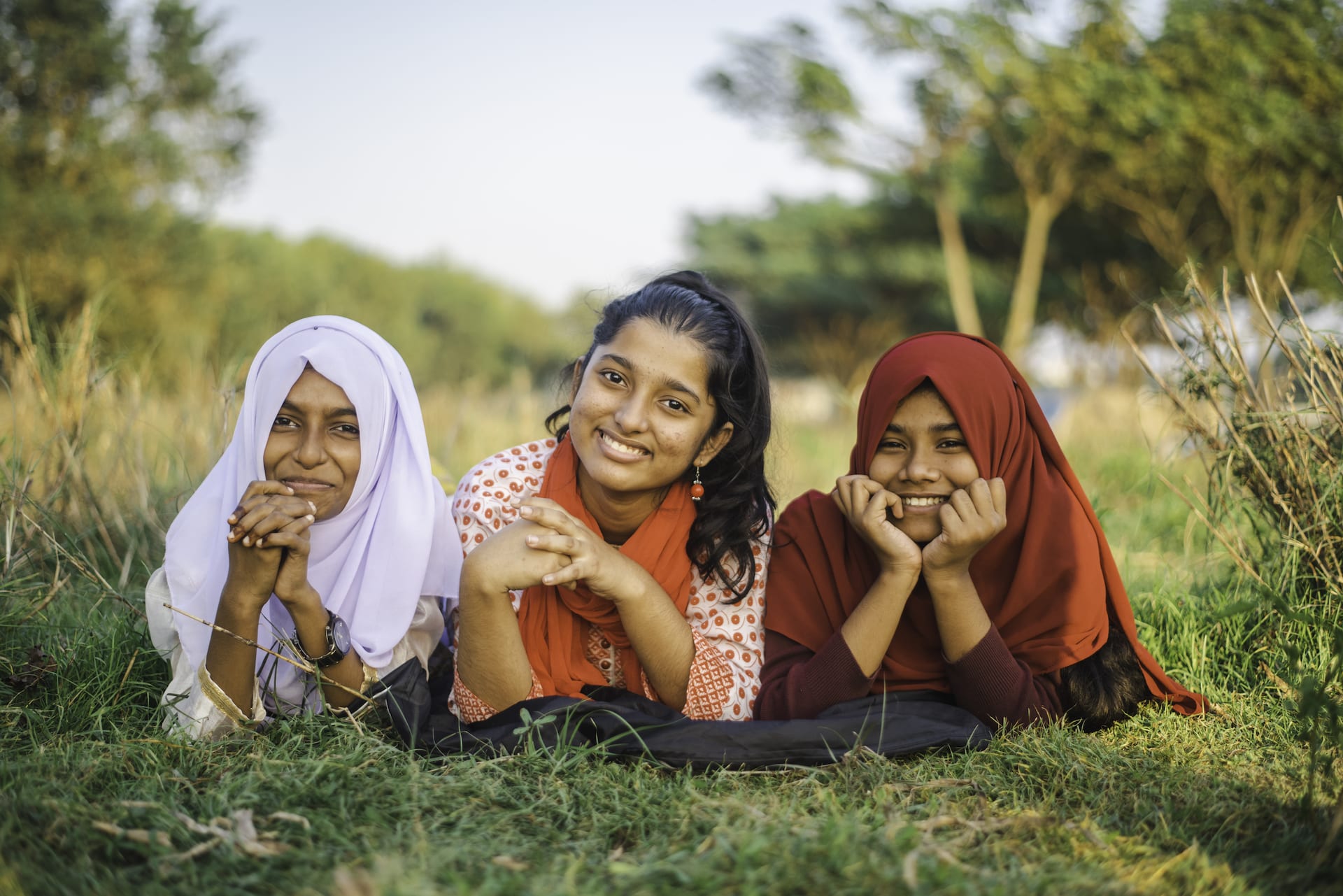
Note: This content includes photos from staged bridal photoshoots to raise awareness against child marriage. The photoshoots were conducted with parental permission and the girls in these images are not actual child brides.
Tisha gazes blankly at the camera with kohl-lined eyes. She is veiled in silken red fabric and festooned with golden jewelry. Her lips are painted ruby red, her plump young cheeks a delicate pink. Her skirt trails clumsily after her. It’s too long. It was made for an older woman.
Tisha is 14 years old, and this is a wedding shoot.
Nearby, a group of women have gathered. They cluster together, muttering, their faces wreathed in frowns. The photographer swallows nervously. He can feel their tension. Suddenly, an idea comes to him. He whispers in Tisha’s ear. A smile spreads slowly across her face, lighting it up like a sunrise.
Staring down the barrel of the camera, she boldly proclaims a short phrase in Bengali.
“Stop the wedding.”

14-year-old Tisha participated in a staged bridal photoshoot to raise awareness against child marriage. In her home country of Bangladesh, 15 per cent of girls are married by age 15.
Child marriage—marriage before the age of 18, including informal unions—is a violation of children’s rights. Despite being illegal in many countries, it remains widespread. Alarmingly, the effects of the COVID-19 pandemic are predicted to turbo-charge the harmful practice, putting 10 million more girls at risk over the next decade.
“Child marriage creates a nightmarish legal trap for children,” says Fraidy Reiss, founder of advocacy organization Unchained at Last. “They can be entered into the marriage by parents and/or a judge, with little or no input from them.”
WATCH NOW: Experts share about the pandemic’s impact on child marriage rates in this 7.5-minute documentary.
In Bangladesh, 15 per cent of girls are already married by age 15 and more than 50 per cent by 18 years old. Despite appearances, Tisha is not one of them. Several of her friends are already wed, though. “When I walk past their homes carrying books and a school bag, it hurts me to see girls my age instead washing dishes and providing service for their in-laws,” she says.
It’s why she agreed to participate in a staged wedding photoshoot for Compassion. Along with Yolane, 14, in Brazil, and 13-year-olds Lauri from the Dominican Republic and Mart in Ethiopia, she dressed in bridal finery to boldly proclaim the dangers of child marriage.
“No teenagers should get married,” says Tisha, passionately. “When someone has so much scope in life and so many things to do in the future, why sacrifice that? Marriage is not the solution to life’s problems.”
A generation of child marriage
The pandemic is increasing the risk of child marriage in several ways. Education is proven to prevent early marriage, with each year of secondary school reducing a girl’s likelihood of marrying before age 18. Yet school closures triggered by COVID-19 may cause girls to drop out entirely or be less likely to re-enrol.
“COVID has created a situation where we know that millions of children will not go back to school,” says Sidney Muisyo, Chief Program Officer for Compassion International. “Every girl who gets educated delays marriage and delays bearing children. The health of the mother, the health of the children and the health of the family is impacted for years to come, simply because of an early marriage.”
Along with school closures, the pandemic has isolated children from social services. Already vulnerable girls have been cut off from teachers, health professionals, the justice system and other services that can recognize and support a girl in crisis.
Finally, the pandemic has plunged families into desperate poverty. They were poor before. They are poorer now. “When a family is struggling with the basic necessities of life, like food, any child is an extra mouth to feed, and if a girl can get married, that is one less mouth they have to worry about,” says Sidney Muisyo.
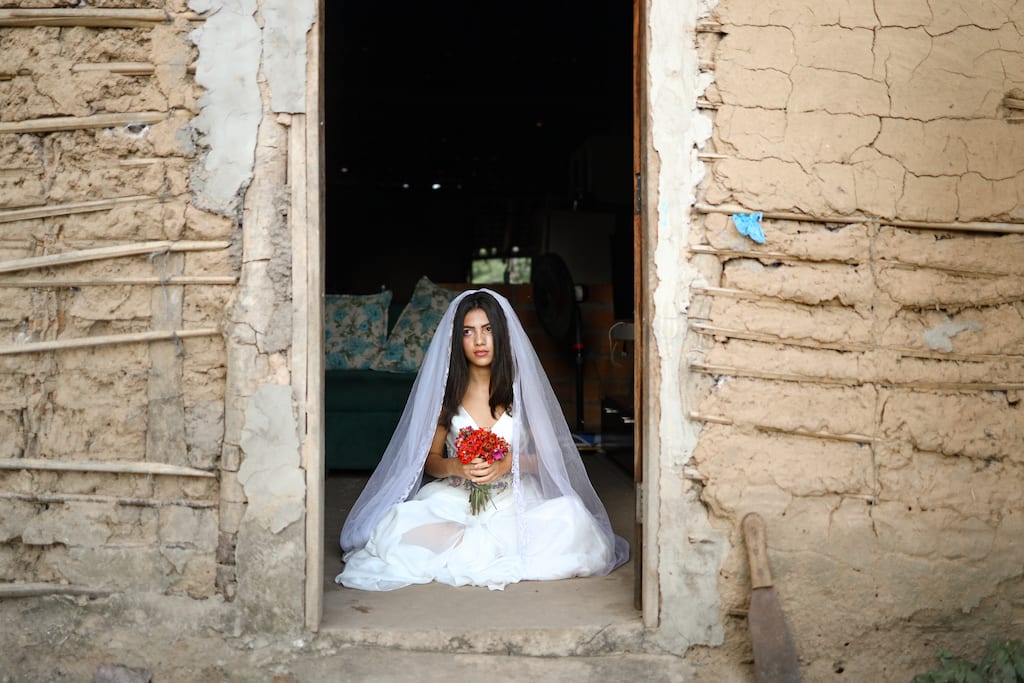
Along with three other outspoken teen girls around the world, 14-year-old Yolane in Brazil participated in a staged bridal photoshoot to speak up against child marriage. Her older sister was married at her age now.
In Brazil, 14-year-old Yolane leans against her simple mud home. She’s dressed in a sagging satin wedding gown and is the same age her sister was when she chose to wed.
“First, she left home to live with her boyfriend,” says Yolane. “That’s how it happens most of the time here.” A year later, her sister fell pregnant.
“A lot of parents encourage girls to marry because girls are seen as a burden at home,” she says. “That’s not right.”

Far from being a child bride, Yolene dreams of one day building a two-story home for her family.
For parents, it can be a complex and heartbreaking decision. Some feel forced to choose between their daughter’s future and their family’s survival, while others believe she will be better off married.
Through awareness campaigns, Compassion’s partners all over the world are helping to prevent countless early marriages. Yet despite their best efforts, there are still a small number of children who depart the program early to be wed. Of this number, the overwhelming majority are girls.
“When a man approaches [their daughter] with a promise of a better life and financial security, they get married even if they are still children,” says Letera, a Compassion centre director in Ethiopia.
A marriage to hardship and hard labour
Tisha, Yolane, Lauri and Mart look beautiful—if alarmingly young—in their wedding finery. The reality for young brides is far less glamorous. For girls living in poverty, there is often no ceremony or festivities at all. “The fairy tale they imagined soon crumbles,” says Compassion tutor Claudeane in Brazil.
Child marriage denies girls the opportunity to develop their full potential. They are not only robbed of their childhood but are often socially isolated. Taken out of school and separated from family and friends, they assume responsibilities they are too young for.
“It is basically a marriage to hardship and to hard labour,” says Sidney Muisyo.

13-year-old Lauri from the Dominican Republic is another teen who took part in staging this provocative photoshoot to raise awareness of the horrors of child marriage.
In contrast, 13-year-old Lauri swings a hula hoop as her friends joyfully cheer her on. It’s starkly different from the scene just hours ago, when Lauri wore white lace for the staged bridal shoot. She says she won’t consider marriage until after she has conquered her dreams.
“A girl who gets married young must drop out of school, dedicate themselves to cleaning the house and take care of a child and a man that she doesn’t understand,” she says. “Instead of moving forward, it is like her life has frozen.”
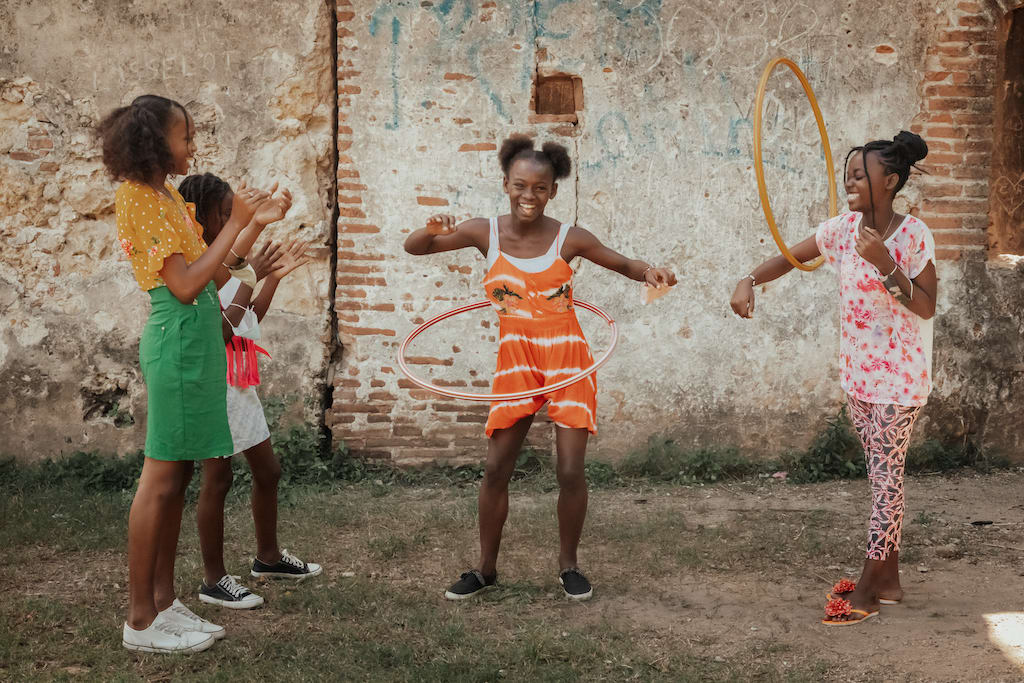
Lauri and her friends play joyfully, a stark contrast to other girls their age who are forced into early marriages.
Once married, the pressure to become pregnant can be intense, even though girls’ young bodies are not always ready to give birth. “A girl is not prepared physically or mentally to assume the role of a grown-up,” says Lauri.
In Ethiopia, Mart stares into a shard of a broken mirror. The teenager looking back at her, dressed in richly embroidered robes, reflects a sombre alternative reality.
Forty per cent of Ethiopian girls are married by 18.
“Girls should be in school,” Mart says firmly. “They should be allowed to pursue their education and become who God wants them to be. Everything is good when it is done in its own appropriate time.”

Mart, 13, in Ethiopia is the fourth girl who was a part of this global protest against child marriage.
Since poverty is one of the leading drivers of child marriage, it’s mainly occurring in lower-income countries. But girls in higher-income nations are at risk, too. In the United States, Massachusetts allows children as young as 12 to get married with the consent of a judge.
In Australia, the UK and Canada, a 16-year-old can wed, with parental consent. “A lot of people don’t realize that child marriage not only is legal in most of the United States, but also is happening at an alarming rate,” says Fraidy Reiss.
Join the young advocates against child marriage
While the situation facing 10 million young girls is desperate, it is not definite.
At a grassroots level, girls like Tisha, Yolane, Lauri and Mart—encouraged by their supportive parents and cheered on by Compassion centre staff—are sharing their powerful message.
“There’s a time for everything,” says Lauri. “Our age is the time to mature, play, grow, learn and develop our skills and minds to build a future where we can handle responsibilities like marriage.”
The four girls are part of their local Compassion child development centres, where dedicated staff and tutors help ensure they are known, loved and protected.
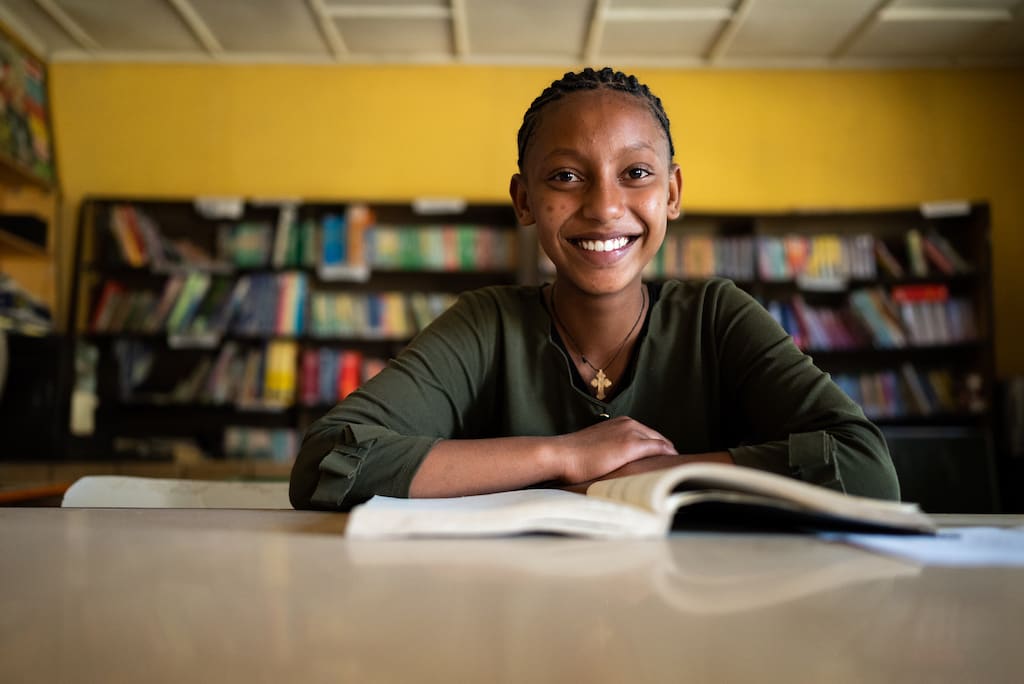
Mart dreams of finishing her education and bringing her family out of poverty.
In the Dominican Republic, centre staff have increased their counselling efforts with girls and their families. In Ethiopia, guest speakers answer parents’ questions. A girls’ club in Brazil prepares teenagers for the joy and challenges of womanhood. In Bangladesh, parents and children gather at the centre in small groups to discuss the dangers of child marriage.
“Our role is to be there to encourage their dreams and show them a new path,” explains tutor Claudeane in Brazil. In Ethiopia, centre director Letera agrees. “We need to emphasize that girls are not the property of the husbands or their parents but are changemakers,” she says. “Girls can be wives, mothers and productive members of society who can contribute to the development of their country.”
Lauri intends to become a pediatrician, and Tisha, a doctor. Yolane plans to build a two-story home for her family—with a pool in the backyard. She helped build their current mud home. With quiet determination, Mart says, “My dream is to pursue my education and bring my family out of poverty.”
In Bangladesh, as the camera clicks, Tisha’s proclamation—“Stop the wedding!”—has an instant and dramatic effect. The women look at one another and laugh, their tension dissipating as they understand the purpose of the staged photoshoot. All too often, they see the real thing.
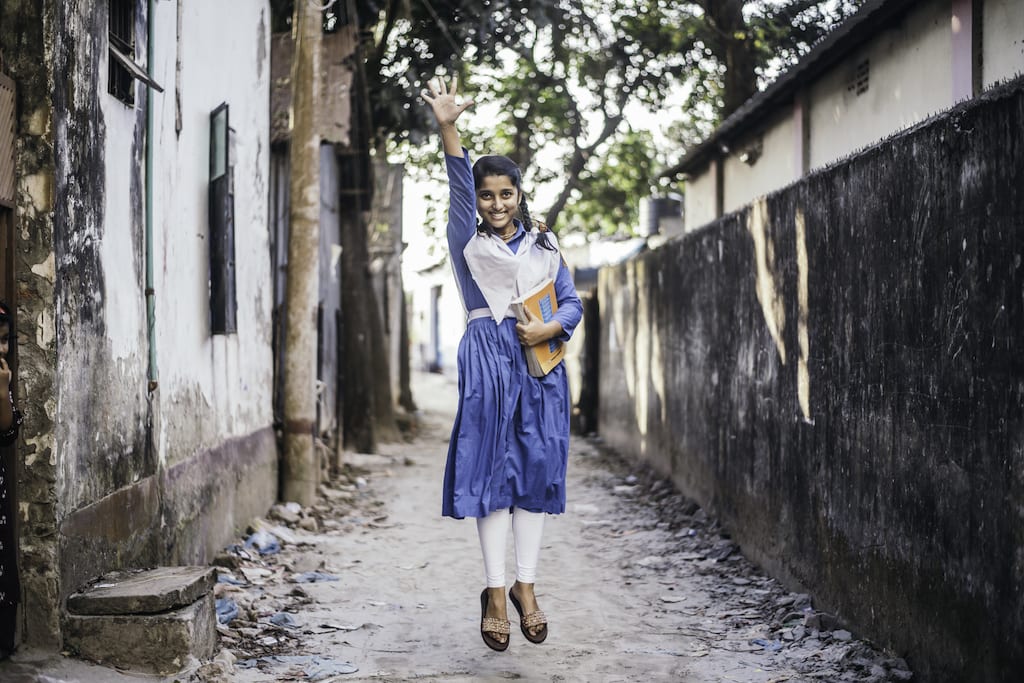
Tisha wears her school uniform—much more comfortable attire for the teen.
Back at home, Tisha swaps the scarlet and gold sari for her neat blue uniform. She enjoyed wearing the beautiful clothes for a day. But this dress feels much more comfortable.
Shrugging on her backpack, she heads to school.
Child sponsorship empowers girls to stay in school and speak up for their rights. You can join Tisha, Yolane, Lauri and Mart in their advocacy by sponsoring a girl.
Words by Zoe Noakes, with Alyssa Esparaz. Photography and field reporting by J. Sangma (Bangladesh), Sara Navarro (Brazil), Yrahisa Mateo (Dominican Republic) and Tigist Gizachew (Ethiopia).



